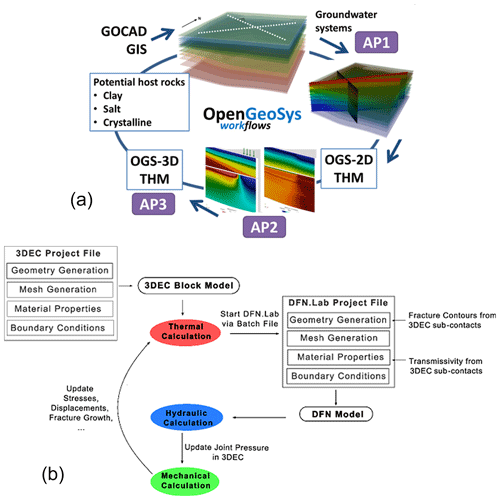AREHS: effects of changing boundary conditions on the development of hydrogeological systems: numerical long-term modelling considering thermal–hydraulic–mechanical (–chemical) coupled effects
The objective of the AREHS project, funded by BASE (FKZ 4719F10402), is to model the effects of changing external boundary conditions on the hydrogeologically relevant parameters and effects (e.g. hydraulic permeability, porosity, migration pathways, fluid availability, hydraulic gradients) of a generic geological repository in Germany in all three potential host rocks (clay, salt, and crystalline rocks) in its hydrogeological setting. Special attention is paid to the cyclic mechanical loading due to glaciation events. This results in stress changes (M – mechanical processes) as well as induced temperature effects (T – thermal processes) due to permafrost and warm periods. Since the thermal, hydraulic (H – hydraulic processes), and mechanical processes are strongly coupled, they have to be covered by state-of-the-art coupled thermal–hydraulic–mechanical (THM) (C) modelling.
The presentation consists of a (a) presentation of important findings for all three host rock types and a (b) presentation of the overall workflow. Complex, time-varying boundary conditions have been formulated for modelling glacial cycles. Investigating the effects of these boundary conditions with THM simulation reveals a variety of coupling effects.
To conduct the complex modelling workflow for claystone and salt rock effectively, an automated workflow was developed and tested. It handles the transformation from a simulator-independent geological model to a numerical model specific to the simulator. This contains a suitable finite-element mesh and a parameterization of the fully coupled or optionally isolated thermal–hydraulic–mechanical processes, which are implemented and executed in the OpenGeoSys simulator. Simulation results are presented for selected physical quantities at characteristic local and temporal points with respect to the position of a migrating glacier. The investigation results are reproducible through full automation, container deployment, and a continuous integration process running on a GitLab instance (see Fig. 1a). To simulate the response of a fractured crystalline rock mass to THM impacts, the explicit integration of the fracture network in numerical models is necessary. The workflow couples the distinct element method (DEM) software “3DEC” and the discrete fracture network (DFN) software “DFN.Lab” automatically (Fig. 1b).






